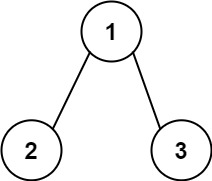LeetCode Link: 112. Path Sum
Language: C#
Problem Statement
Given the root of a binary tree and an integer targetSum, return true if the tree has a root-to-leaf path such that adding up all the values along the path equals targetSum.
A leaf is a node with no children.
Examples
Example 1:

Input: root = [5,4,8,11,null,13,4,7,2,null,null,null,1], targetSum = 22
Output: true
Explanation: The root-to-leaf path with the target sum is shown.
Example 2:

Input: root = [1,2,3], targetSum = 5
Output: false
Explanation: There two root-to-leaf paths in the tree:
(1 –> 2): The sum is 3.
(1 –> 3): The sum is 4.
There is no root-to-leaf path with sum = 5.
Example 3:
Input: root = [], targetSum = 0
Output: false
Explanation: Since the tree is empty, there are no root-to-leaf paths.
Constraints
- The number of nodes in the tree is in the range [0, 5000].
- -1000 <= Node.val <= 1000
- -1000 <= targetSum <= 1000
Solution
/**
* Definition for a binary tree node.
* public class TreeNode {
* public int val;
* public TreeNode left;
* public TreeNode right;
* public TreeNode(int val=0, TreeNode left=null, TreeNode right=null) {
* this.val = val;
* this.left = left;
* this.right = right;
* }
* }
*/
public class Solution
{
public bool HasPathSum(TreeNode root, int targetSum)
{
return HasSum(root, targetSum, 0);
}
private bool HasSum(TreeNode root, int target, int sum)
{
if (root is null)
{
return false;
}
sum += root.val;
if (root.left is null && root.right is null)
{
return sum == target;
}
return HasSum(root.left, target, sum) || HasSum(root.right, target, sum);
}
}
Complexity
Time Complexity: O(N)
Space Complexity: O(1)